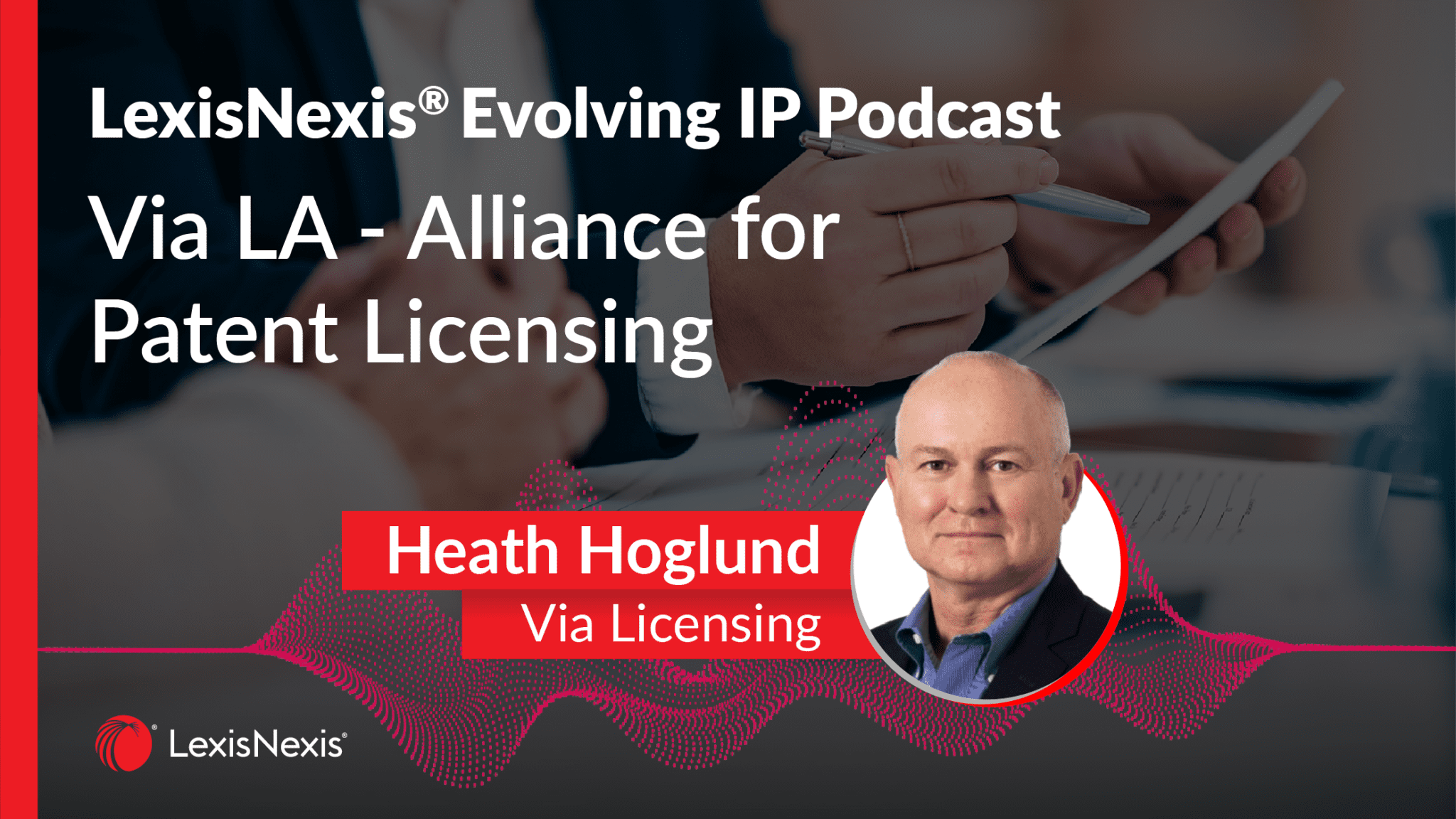Episode 6: Via LA – Alliance for Patent Licensing

Introduction
Episode 6 of the LexisNexis Evolving IP podcast features Heath Hoglund, President of Via Licensing – Alliance for Patent Licensing.
In this episode, we meet with Heath to discuss technology’s rapid evolution and the role of patent pools in facilitating interoperability and innovation.
Heath highlights the benefits of patent pools for both innovators and consumers, and how they can streamline licensing, support technological advancement and ensure fair competition, particularly aiding small and medium-sized enterprises.
Podcast Host
- Francesca Levoir, Head of Brand Strategy and Solutions Marketing
Expert
- Tim Pohlmann, SEP Analytics Director, LexisNexis Intellectual Property Solutions
Conversation Highlights
The impact of patent licensing programs and pools on the development of technology
“We continue to see a more expansive pool of patent rights that are relevant to some of the most important technologies that we use in our daily lives.
“That’s really where a patent pool comes in; it creates an opportunity that’s beneficial both for implementing companies or product companies, as well as for the innovative companies that contribute to the standardization.
“Modern technologies can involve many tens, even as many as 100 companies, that contribute one way or another to standardization.
“To go and obtain individual patent licenses from each of those companies would be a really overwhelming task. Likewise, for the patent owners to go and individually license every company that implements a particular technology is similarly just an overwhelming task.
“There’s a unique opportunity there, and that’s the role that we play: creating a more efficient mechanism for providing access to product companies for patent rights and also providing a path for innovators to reap the reward of their investment in innovation in an efficient way.”
On the benefits for the end consumer
“The technological development that’s happened over the last several decades is just phenomenal.
“Part of the reason that happens is that there are a lot of companies willing to make investments in the development of new technologies.
“That happens because there is a reward system for that investment, and that reward system is through patents. The end consumer really benefits from the rapid development of technology that we see, at least in part, driven by the system we have to reward investment in innovation.”
Heath’s advice for SMEs
“The pools really are a simple IP solution, especially for small implementers.
“The simple advice is just to reach out to the pool administrators for whatever standardized technologies you implement.”
On the merger of Via LA and MPEG LA
“When I took the new role at VIA, even during the interview process, I had in mind and brought up that it would make a lot of sense for VIA and MPEG LA to merge.
“There were a lot of similarities. MPEG LA had focused on video, while VIA had focused on audio, but the philosophy and culture of the two organizations were very similar.
“From my perspective, one of the strengths of MPEG LA was that they had already formed a good number of existing programs, so they had over ten existing pools—some of them really successful, some of them not yet successful—but it created a platform for us to have more opportunities.”
What is the outcome of fragmentation?
“The best possible outcome is finding a path to having a single pool for a particular technology.
“It doesn’t always work that way.
“What I say is that it’s still better to have two pools than no pools because with two pools, you do have to get a couple of licenses, but with no pools, there’s a lot more complication.”
Setting the royalty rates within a pool
“Pricing is one of the biggest challenges in setting up a pool program. From our perspective, when we start a program, we aim to find something acceptable to both licensors and licensees.
“As a pool administrator, we really want to find the sweet spot in the market. If you price too high, you end up spending a long-time convincing product companies to take the license.
“Economically, this doesn’t work out well for licensors because all that time spent fighting is time not getting a return on your investment.
“On the other hand, implementers want to be covered, so you need a pool that’s successful.
“Modelling from a licensor’s perspective is important because the time spent gaining market adoption for a new program can significantly affect the present value of dollars. It’s crucial to get licensees in the door as early as possible.”
What does the future hold?
“I continue to see development in new standards with even more market participants contributing.
“I foresee a continued need for patent pools, and frankly, an increasing need for them to provide transparency and clarity to the market.
Heath’s key takeaway
“Patent pools and the development of technology go hand in hand and are mutually beneficial. Patent pools provide transparency and clarity to the market, which is helpful for technology adoption.”
Tim ‘s key takeaway
“Like any product in the market, the best pools prevail because they provide real value.
“Patent pools streamline and facilitate technology adoption, aiming to collect royalties from users and distribute funds to standards developers, supporting continuous innovation.
“In complex markets with numerous players, pools are crucial to ensuring SEP licensing doesn’t hinder technology adoption. Conversely, in markets where technology adoption is unavoidable, pools can gain market power, potentially leading to increased prices.
“Supportive legal and regulatory frameworks are essential for pool formation and success.”



